Teeth Grinding (Bruxism): What’s Behind the Grind?

Our upper and lower teeth are supposed to glide together smoothly, touching only when we are chewing food. Unnatural grinding or clenching can cause wearing and cracking of the teeth, as well as serious jaw impairment.
The reality is that all of us grind our teeth on occasion – when we are angry or anxious, for instance, or when our sleep is disturbed. But when we grind our teeth on a regular basis, it’s a condition called bruxism (from the Greek bryx, meaning a “gnashing of the teeth”).
If bruxing persists, as it does in an estimated 20 percent of the population during waking hours and 8 percent during sleep, it can have a negative effect on tooth enamel, bone, gums and the jaw.
In the past, grinding (sideways movements of the jaws, with the teeth just touching) and clenching (clamping the uppers and lowers together) were believed to be caused by malocclusion (a bad bite). However, the latest research sees lifestyle reflexes – our ways of dealing with anxiety and stress – as the primary cause, with sleep disturbances and malocclusion serving as secondary and tertiary causes.
How Serious is Bruxism?
Bruxism starts early in life while the teeth are still in the process of developing. An estimated 15 percent of children reportedly grind or clench their teeth. Although the condition eventually wanes, with only three percent of the elderly continuing to brux, it takes a toll during the intervening years.
While enamel subject to normal stresses wears down at the rate of .3 millimeters every 10 years, it is not uncommon for bruxers to experience two millimeters of enamel erosion by their mid-twenties. What’s more, nighttime bruxing can occur as often as 40 minutes for every hour of sleep, producing up to 250 pounds of force per square inch. That’s enough pressure to crack a walnut.
Teeth Grinding
Of the two reflexes, teeth grinding is more common during sleep and occurs equally among men and women. Sleep is the time when the brain goes into a semi-resting state but stays alert enough to notice potential alarms, like a dog barking or the blare of a siren. This “disturbance reflex” appears to be exaggerated among those who have airway resistance, causing breathing difficulties during sleep.
In response to sleep disturbances, the brain makes a quick decision as to whether these noises are simply routine, permitting the body to stay asleep, or serious enough to serve as a wake-up call. It is at the moment of arousal from the sleep state that bruxing takes place.
Grinding may also result as a medication side effect among those being treated for depression, developmental disorders and schizophrenia, and among those taking recreational drugs such as ecstasy and cocaine. Certain medications and drugs act on the brain, stimulating it. The resulting brain stimulation is believed to contribute to grinding.
Clenching
Teeth clenching is more likely to occur during the daytime, with women likelier to clench than men. One theory is that women are more predisposed to be vigilant. For example, they are more alert to the sound of a baby crying. This type of conscious attentiveness translates into more frequent closings of the jaw rather than sideways grinding motions.
The Consequences of Bruxism
Over the years, the accumulated toll of bruxing can produce a wide range of damage that includes:
- Front teeth worn down so they are flat and even in length.
- Micro-cracks and broken fillings, eventually leading to nerve damage.
- Teeth ground down to the dentin, causing sensitivity to heat and cold.
- Gum recession, due to pressure on the gum line.
- Loose teeth, caused by the rocking effect of bruxing, and gum pockets, also produced by the back-and-forth rocking effect.
- Headache and aching jaws due to overuse of muscles.
Treatments
While there is no cure for bruxism, the condition can be managed through treatment. If you suspect that you clench or grind your teeth, consult your dentist to undergo a bruxism evaluation. Your dentist is in the best position to evaluate the extent of wear and tear on your teeth, gums and jaw, and to provide a practical remedy to offset further damage.
The Custom-Fitted Bite Plate Remedy
One such practical remedy is the use of a bite plate that has been custom-fitted by your dentist. Wearable day or night, it acts as a bumper guard, absorbing the force of the clenching or grinding. While horseshoe-shaped over-the-counter night guards are also available, they tend to be uncomfortable and are so soft that they may get chewed away. In addition, over-the-counter night guards do not account for occlusal discrepancies that may be the source of your bruxing problems; a night guard custom fabricated by your dentist’s laboratory technician does.
Unfortunately, many of the soft night guards actually stimulate a wearer to grind in their sleep. Although the teeth may be protected by a soft night guard, the muscles and jaw joints will not be protected; thus, many muscle symptoms (such as headaches), will increase with the use of soft appliances. Custom-fitted plates, made of hard acrylic, can help bruxers avoid such problems.
Additional treatments include:
- A custom-fitted oral appliance that treats airway obstruction, to be used as an alternative to the bite plate. This therapy should be supervised by a physician who does regular sleep studies to make sure the oral appliance is effective.
- Orthodontics, when misaligned teeth are part of the problem.
- Stress reduction via psychotherapy, biofeedback, yoga, meditation, vacations, et al.
- For extreme cases, muscle relaxants or botulism toxin (Botox) to minimize spasm in overworked jaw muscles.
- An adjustment to your medications, arranged by your physician in consultation with your dentist.



